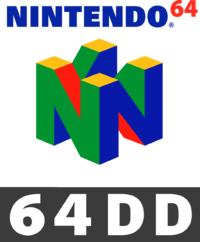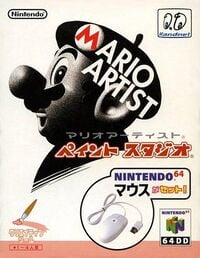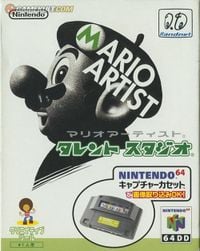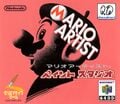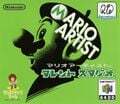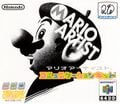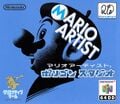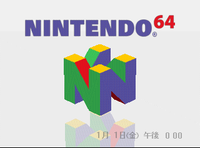Nintendo 64DD: Difference between revisions
mNo edit summary |
m (Text replacement - "{{([Ss]erials|[Rr]elease)\|" to "{{flag list|") |
||
| (245 intermediate revisions by 99 users not shown) | |||
| Line 1: | Line 1: | ||
[[ | {{system infobox | ||
The '''Nintendo 64DD''' ( | |image=[[File:64DD Console.png|250px]] | ||
|generation=Fifth | |||
|release={{flag list|Japan|December 11, 1999}} {{flag list|USA|Planned for 2000 (canceled)}} | |||
|discontinued=February 28, 2001<ref>{{cite|deadlink=y|archive=web.archive.org/web/20010413234643/http://www.randnetdd.co.jp|title=ランドネットホームページ|publisher=Randnet|language=ja|accessdate=May 25, 2024}}</ref> | |||
|predecessor=[[Nintendo 64]] | |||
|successor=[[Nintendo GameCube]] | |||
}} | |||
{{quote|The 64DD sat under your [[Nintendo 64|N64]]. Well, not yours — you didn't have a 64DD.|''{{wp|Official Nintendo Magazine}}''}} | |||
[[File:64DD Logo.png|left|thumb]] | |||
The '''{{wp|64DD|Nintendo 64DD}}''' (short for "'''64 Dynamic Drive'''")<ref>{{cite|author=Schneider, Peer|date=February 9, 2001|url=www.ign.com/articles/2001/02/10/everything-about-the-64dd|title="Everything About the 64DD"|publisher=IGN|accessdate=May 25, 2024}}</ref> is a disk drive unit that, like the [[Family Computer Disk System]], attaches to a [[Nintendo 64]] and can play games in a magnetic disk format, with the disks containing their own internal memory written through the N64 instead of the disk itself. There were also several peripherals used for it. The system was released only in Japan in December 1999, following numerous developmental delays,{{ref needed}} and it was scheduled for release in North America in 2000, but it ended up being a commercial failure both due to its belated Japanese release and due to the way it was sold (mainly through subscription to the Randnet online service, with little to no retail units in stores); consequently, the planned American release was canceled, leaving the add-on exclusive to Japan. | |||
There were four games of the [[Super Mario (franchise)|''Super Mario'' franchise]] released on this console, all in the ''[[Mario Artist (series)|Mario Artist]]'' series; there were also several canceled ''Super Mario'' titles. Overall, there were only ten games released on the Nintendo 64DD, although other games planned for the console were released on the original Nintendo 64, the {{wp|PlayStation (console)|Sony PlayStation}}, the {{wp|Dreamcast|Sega Dreamcast}}, and the next-generation [[Nintendo GameCube]] or were canceled altogether. | |||
{{br|left}} | |||
== | ==Accessories== | ||
{{part conjecture}} | |||
===Mouse=== | |||
[[File:MAPaintStudio2.jpg|thumb|left|''Mario Artist: Paint Studio'' bundle]] | |||
'''NUS-017''', this replaced analog stick input to allow more precise cursor movements in games that supported it, such as the ''Mario Artist'' series. | |||
===Modem Cartridge=== | |||
'''NUS-029''', this allowed the Nintendo 64 connect to Randnet. ''[[Mario Artist: Communication Kit]]'' made use of this accessory directly. | |||
===AV-In Cartridge=== | |||
[[File:MATalentStudio2.jpg|thumb|''Mario Artist: Talent Studio'' bundle]] | |||
'''NUS-028''', this allowed the Nintendo 64 to take in RCA and microphone as input. ''[[Mario Artist: Talent Studio]]'' made use of this accessory. | |||
{{stub|section=yes}} | |||
{{br}} | |||
==''Super Mario'' games== | |||
===Released=== | |||
*''[[Mario Artist: Paint Studio]]'' | |||
*''[[Mario Artist: Talent Studio]]'' | |||
*''[[Mario Artist: Communication Kit]]'' | |||
*''[[Mario Artist: Polygon Studio]]'' | |||
====Canceled==== | |||
*''[[Mario Artist (series)#Canceled game|Mario Artist: Sound Studio]]'' | |||
*''[[Mario Party]]'' | |||
*''[[Mario Party 2]]'' | |||
*''[[Super Mario 64 2]]'' | |||
*''[[List of unreleased media#Super Mario 64: Disk Ban|Super Mario 64: Disk Ban]]''<ref>{{cite|author=Bodamin, Kadu|url=www.reinodocogumelo.com/2014/06/super-mario-64-disk-version-existe-fa.html|title=Super Mario 64 Disk Version existe? Fã mostra em vídeo esta curiosa versão do game rodando em Nintendo 64 japonês|language=pt|publisher=Reino do Cogumelo|accessdate=May 25, 2024}}</ref><ref>{{cite|url=gamingafterhours.com/2014/06/24/super-mario-64dd-version-discovered-in-japan|title=Super Mario 64DD Version Discovered in Japan|publisher=Gaming After Hours|author=Kim, Byungsuk|date=June 24, 2014|accessdate=May 25, 2024}}</ref> | |||
*''[[List of Paper Mario pre-release and unused content|Super Mario RPG 2]]'' (released on the Nintendo 64 as ''[[Paper Mario]]'') | |||
==Game gallery== | |||
<gallery> | |||
MAPaintStudio.jpg|''[[Mario Artist: Paint Studio]]'' | |||
MAPaintStudio2.jpg|''Mario Artist: Paint Studio'' bundle | |||
MATalentStudio.jpg|''[[Mario Artist: Talent Studio]]'' | |||
MATalentStudio2.jpg|''Mario Artist: Talent Studio'' bundle | |||
MACommunicationKit.jpg|''[[Mario Artist: Communication Kit]]'' | |||
Mario Artist Polygon Studio.jpg|''[[Mario Artist: Polygon Studio]]'' | |||
</gallery> | |||
==Media== | |||
{{media missing|more=yes|Boot tune|section=yes}} | |||
{{media table | |||
|mediafor=Nintendo 64DD | |||
|file1=Nintendo 64DD start up.oga | |||
|title1=Boot-up sound | |||
|description1=A recording or re-creation of an early Nintendo 64DD boot-up sound. | |||
|length1=0:05 | |||
}} | |||
==Trivia== | ==Trivia== | ||
* | [[File:64DD Boot Screen.png|thumb|200px|Boot screen]] | ||
*If there is no game inserted in the system, the start-up appears as usual, but [[Mario]] then appears and plays around with the Nintendo 64 logo. The N shape changes when Mario interacts with it.<ref>{{cite|author=Benaim, Jason|date=May 5, 2013|url=https://www.youtube.com/watch?v=b6tECCX3B4g|title=64DD emulation test|publisher=YouTube|accessdate=February 9, 2016}}</ref> | |||
*''[[Mario Party]]'' originally [[List of Mario Party pre-release and unused content|was supposed]] to be compatible with the Nintendo 64DD, suggesting that ''[[Mario Party 2]]'' was originally [[List of Mario Party 2 pre-release and unused content|supposed to serve as]] an expansion disk to it.<ref>{{cite|author=adonfjv|date=June 18, 2009|url=https://www.youtube.com/watch?v=yKu5lABxR2Q|title=Mario Party PAL with 64DD error 31 gameshark|publisher=YouTube|accessdate=May 12, 2018}}</ref> | |||
*The official Japanese website for the 64DD listed various online features for the ''Mario Artist'' games as having gone live, including uploading and downloading creations, entering creations into contests, and sending creations to a sticker/postcard manufacturer who would then ship the finished product to a specified postal address.<ref>{{cite|url=https://web.archive.org/web/20150701183041/http://www.nintendo.co.jp/nom/9911/03/index.html|title=掲示板!? ゲームデータの追加!? ネットサービスについて、もっとくわしく!|accessdate=July 16, 2024|date=October~November 1999|publisher=Nintendo of Japan}}</ref> | |||
*[[N64 Rainbow Road#F-Zero X|N64 Rainbow Road]] in ''F-Zero X'' has added functionality when the player uses the Nintendo 64DD disc ''F-Zero X Expansion Kit'', with which a [[:File:FZX Rainbow Road.oga|rock version]] of the ''Mario Kart 64'' track version's theme is played when the player drives on that racetrack. | |||
{{br}} | |||
==References== | |||
{{NIWA|Bulbapedia=1|FZeroWiki=Nintendo 64|FireEmblem=Fire Emblem 64|NWiki=1|StrategyWiki=Category:Nintendo 64DD|WiKirby=Kirby 64: The Crystal Shards|WikiBound=Nintendo 64|ZeldaWiki=Nintendo 64}} | |||
<references/> | |||
{{Japan- | {{Systems}} | ||
[[Category: | [[Category:Japan-only systems]] | ||
[[Category:Systems]] | |||
[[Category:Accessories]] | |||
[[de:Nintendo 64DD]] | |||
[[it:Nintendo 64DD]] | |||
Latest revision as of 20:10, September 27, 2024
| Nintendo 64DD | |
|---|---|
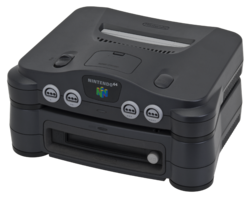
| |
| Generation | Fifth generation |
| Release date | |
| Discontinued | February 28, 2001[1] |
| Predecessor | Nintendo 64 |
| Successor | Nintendo GameCube |
- “The 64DD sat under your N64. Well, not yours — you didn't have a 64DD.”
- —Official Nintendo Magazine
The Nintendo 64DD (short for "64 Dynamic Drive")[2] is a disk drive unit that, like the Family Computer Disk System, attaches to a Nintendo 64 and can play games in a magnetic disk format, with the disks containing their own internal memory written through the N64 instead of the disk itself. There were also several peripherals used for it. The system was released only in Japan in December 1999, following numerous developmental delays,[citation needed] and it was scheduled for release in North America in 2000, but it ended up being a commercial failure both due to its belated Japanese release and due to the way it was sold (mainly through subscription to the Randnet online service, with little to no retail units in stores); consequently, the planned American release was canceled, leaving the add-on exclusive to Japan.
There were four games of the Super Mario franchise released on this console, all in the Mario Artist series; there were also several canceled Super Mario titles. Overall, there were only ten games released on the Nintendo 64DD, although other games planned for the console were released on the original Nintendo 64, the Sony PlayStation, the Sega Dreamcast, and the next-generation Nintendo GameCube or were canceled altogether.
Accessories[edit]
This article's name is conjectural for a part of its content. If an official name is found for the currently unnamed portion of content, it may need to be split into a new article.
Mouse[edit]
NUS-017, this replaced analog stick input to allow more precise cursor movements in games that supported it, such as the Mario Artist series.
Modem Cartridge[edit]
NUS-029, this allowed the Nintendo 64 connect to Randnet. Mario Artist: Communication Kit made use of this accessory directly.
AV-In Cartridge[edit]
NUS-028, this allowed the Nintendo 64 to take in RCA and microphone as input. Mario Artist: Talent Studio made use of this accessory.
 This section is a stub. You can help the Super Mario Wiki by expanding it.
This section is a stub. You can help the Super Mario Wiki by expanding it.
Super Mario games[edit]
Released[edit]
- Mario Artist: Paint Studio
- Mario Artist: Talent Studio
- Mario Artist: Communication Kit
- Mario Artist: Polygon Studio
Canceled[edit]
- Mario Artist: Sound Studio
- Mario Party
- Mario Party 2
- Super Mario 64 2
- Super Mario 64: Disk Ban[3][4]
- Super Mario RPG 2 (released on the Nintendo 64 as Paper Mario)
Game gallery[edit]
Media[edit]
| It has been requested that more audio and/or video files related to this section be uploaded. Specific(s): Boot tune Please upload all related music, sound effects, voice clips, or any videos for this section. See the help page for information on how to get started. |
| File info 0:05 |
Trivia[edit]
- If there is no game inserted in the system, the start-up appears as usual, but Mario then appears and plays around with the Nintendo 64 logo. The N shape changes when Mario interacts with it.[5]
- Mario Party originally was supposed to be compatible with the Nintendo 64DD, suggesting that Mario Party 2 was originally supposed to serve as an expansion disk to it.[6]
- The official Japanese website for the 64DD listed various online features for the Mario Artist games as having gone live, including uploading and downloading creations, entering creations into contests, and sending creations to a sticker/postcard manufacturer who would then ship the finished product to a specified postal address.[7]
- N64 Rainbow Road in F-Zero X has added functionality when the player uses the Nintendo 64DD disc F-Zero X Expansion Kit, with which a rock version of the Mario Kart 64 track version's theme is played when the player drives on that racetrack.
References[edit]
- ^ ランドネットホームページ. Randnet (Japanese). Archived April 13, 2001, 23:46:43 UTC from the original via Wayback Machine. Retrieved May 25, 2024.
- ^ Schneider, Peer (February 9, 2001). "Everything About the 64DD". IGN. Retrieved May 25, 2024.
- ^ Bodamin, Kadu. Super Mario 64 Disk Version existe? Fã mostra em vídeo esta curiosa versão do game rodando em Nintendo 64 japonês. Reino do Cogumelo (Portuguese). Retrieved May 25, 2024.
- ^ Kim, Byungsuk (June 24, 2014). Super Mario 64DD Version Discovered in Japan. Gaming After Hours. Retrieved May 25, 2024.
- ^ Benaim, Jason (May 5, 2013). 64DD emulation test. YouTube. Retrieved February 9, 2016.
- ^ adonfjv (June 18, 2009). Mario Party PAL with 64DD error 31 gameshark. YouTube. Retrieved May 12, 2018.
- ^ October~November 1999. 掲示板!? ゲームデータの追加!? ネットサービスについて、もっとくわしく!. Nintendo of Japan. Retrieved July 16, 2024.
| Video game systems and add-ons | |
|---|---|
| Nintendo home consoles | Family Computer/Nintendo Entertainment System (Family BASIC, Family Computer Disk System) • Super Famicom/Super Nintendo Entertainment System (Satellaview, Super Game Boy) • Nintendo 64 (Nintendo 64DD) • Nintendo GameCube (Game Boy Player) • Wii (Virtual Console, WiiWare) • Wii U (Virtual Console) • Nintendo Switch |
| Nintendo handhelds | Game & Watch • Game Boy • Virtual Boy • Game Boy Color • Game Boy Advance • Nintendo DS (Nintendo DSi, DSiWare) • Nintendo 3DS (Virtual Console) • Nintendo Switch |
| Other | MS-DOS • VS. System • Nintendo PlayChoice-10 • Nintendo Super System • Nelsonic Game Watch • Super Mario Bros. Watch • Gamewatch Boy • Philips CD-i • Mini Classics • Triforce • Visteon Dockable Entertainment System • Classics • LodgeNet |
